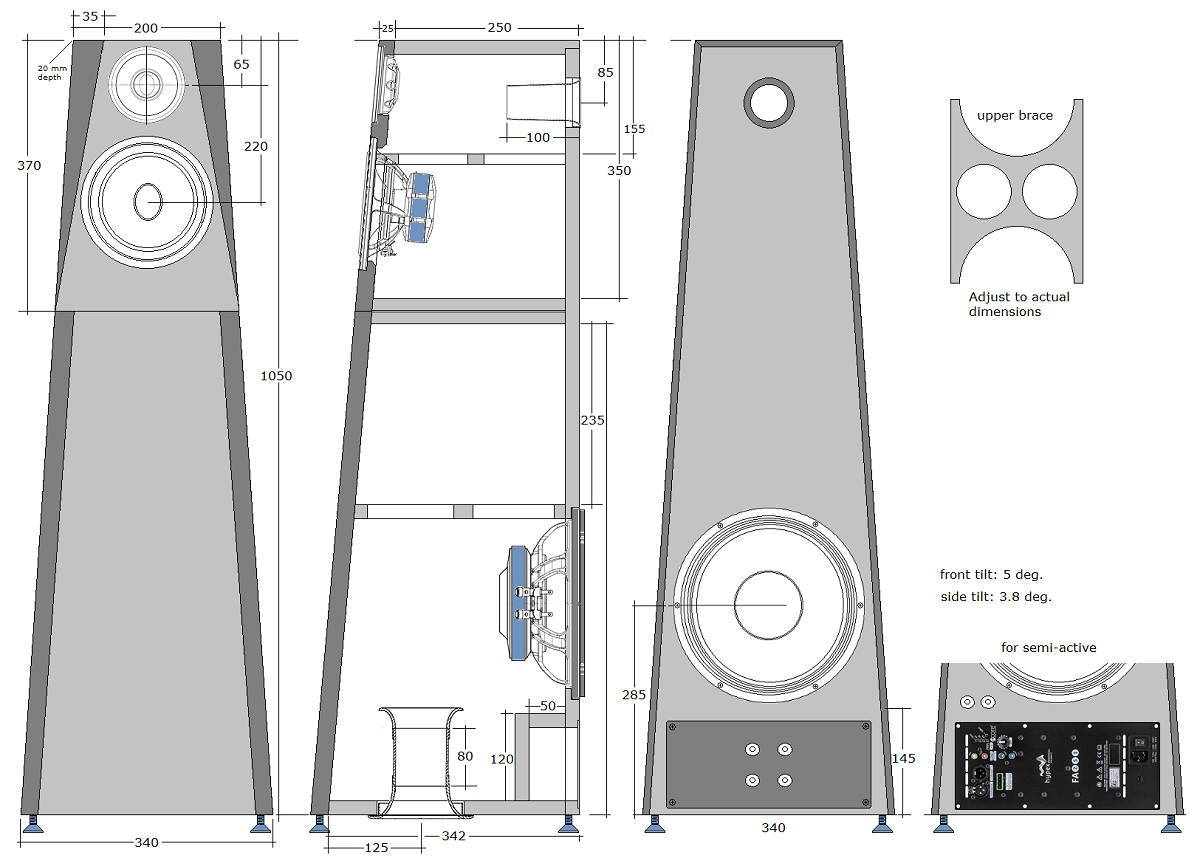ScanSpeak
Ellipticor-2F8
Copyright 2023 © Troels Gravesen
Go to on this page:
DRIVERS CROSSOVER CABINET WORKSHOP PICS MEASUREMENTS
SPEAKER-KIT CROSSOVER LAYOUT HYPEX PROGRAMMING
In hindsight, my
ATELL-3 was a keeper, but I was desperate for space and had to let
it go. Actually I may have to lend these to friends to have some space
at home.... Anyway, since then I wanted to make a semi-active version
together with a fully passive version, thus the 8 Ohms Ellipticor
18WE/8542T00 for mid-bass in order to keep final system impedance
relatively high.
With the Viawave ribbon tweeter not being available I decided on
the Ellipticor D2404/552000, being more expensive - but
doing so well in my Ellipticor-A50 it had to be this tweeter.
With the Hypex module running the bass, the MT-section impedance stays above
7.1 Ohms - and you have almost
infinite options for room-adaption, something very much in demand as
room acoustics leaves a lot to be desired for most.
My 32 wpc EAR-861 runs the fully passive version from its 8 Ohm tabs
without trouble.
I also wanted to use the magnificent Faital 10RS350 for bass as it does
the same as the AudioTechnology 10C77 - and at around a third
of the price. If you're a strong believer in high cost equals better
performance, the AudioTechnology
10C77-25-10-KAP or the ScanSpeak
28W/4878T01 can be used, but only with the Hypex module as I don't
have the drivers and can't ensure proper function from the passive Faital bass
crossover.
Now, why should you build a speaker like this? Well, first of all it
isn't big. Everything is relative, but it's not large like the
Ellipticor-3 or the
SEAS
CNO-4, speakers similar in design, but building on 2½-way
philosophy. The ScanSpeak 7" Ellipticor driver has a phenomenal power
handling and can be pushed extremely hard before distortion sets in.
So, you need a modest sized speaker, that all the same can produce a
significant soundstage and create some potent bass. You want the
benefits of a basically 2-way system in terms of simple crossover with
no high-pass filter to the midrange. It has its benefits, but also its
limitations in terms of fullness and power handling. Building the Hypex
version you get the benefits of almost infinite room adaption, which is
by far the most common problem due to inadequate room acoustics and not
least speaker placement.
You may furthermore like this design because you have a smaller, but
good sounding amplifier that together with the Hypex module can do stuff
it couldn't do alone. 20-30 watts is enough to drive the MT section.
The cabinets, as seen here, are seriously heavy due to the reinforced
bass cabinet, which allows uncoloured sound. What you hear comes from
the drivers, not from resonating cabinets.

Basics:
3-driver speaker.
Dimensions: 20/34 x 25/36 x 105 cm, WxDxH (pyramid)
System sensitivity: 88 dB/2.8V/1 meter.
Impedance: 4-8 Ohms.
Power requirement: 20+ watts/channel (semi-active version)
Power handling: 100 watts.
Useful links (Please
follow all links before e-mailing!):
http://www.troelsgravesen.dk/tips.htm
http://www.troelsgravesen.dk/tips.htm#CONSTRUCTION_OF_CROSSOVERS
http://www.troelsgravesen.dk/crossovers.htm
http://www.troelsgravesen.dk/LCR-RC.htm
http://www.troelsgravesen.dk/Inverted-Polarity.htm
http://www.troelsgravesen.dk/choices.htm
http://www.troelsgravesen.dk/power-handling.htm
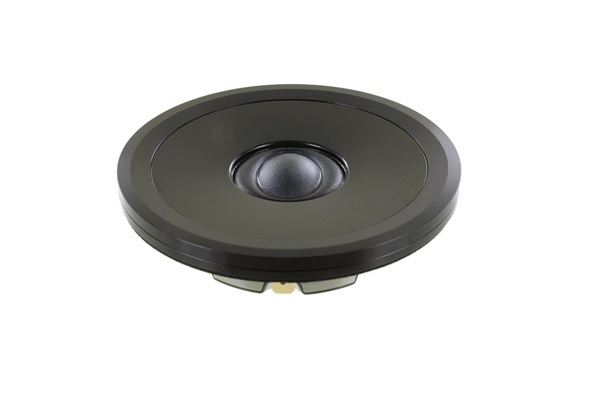
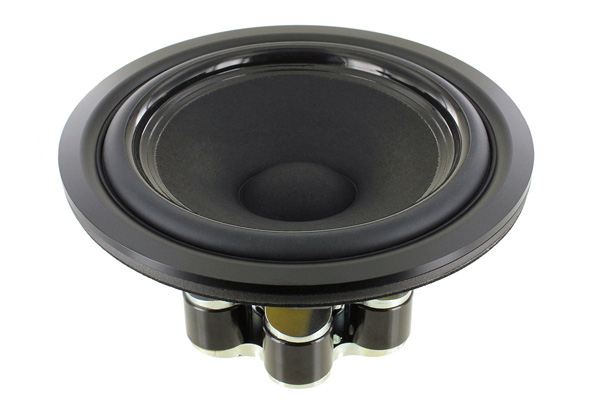
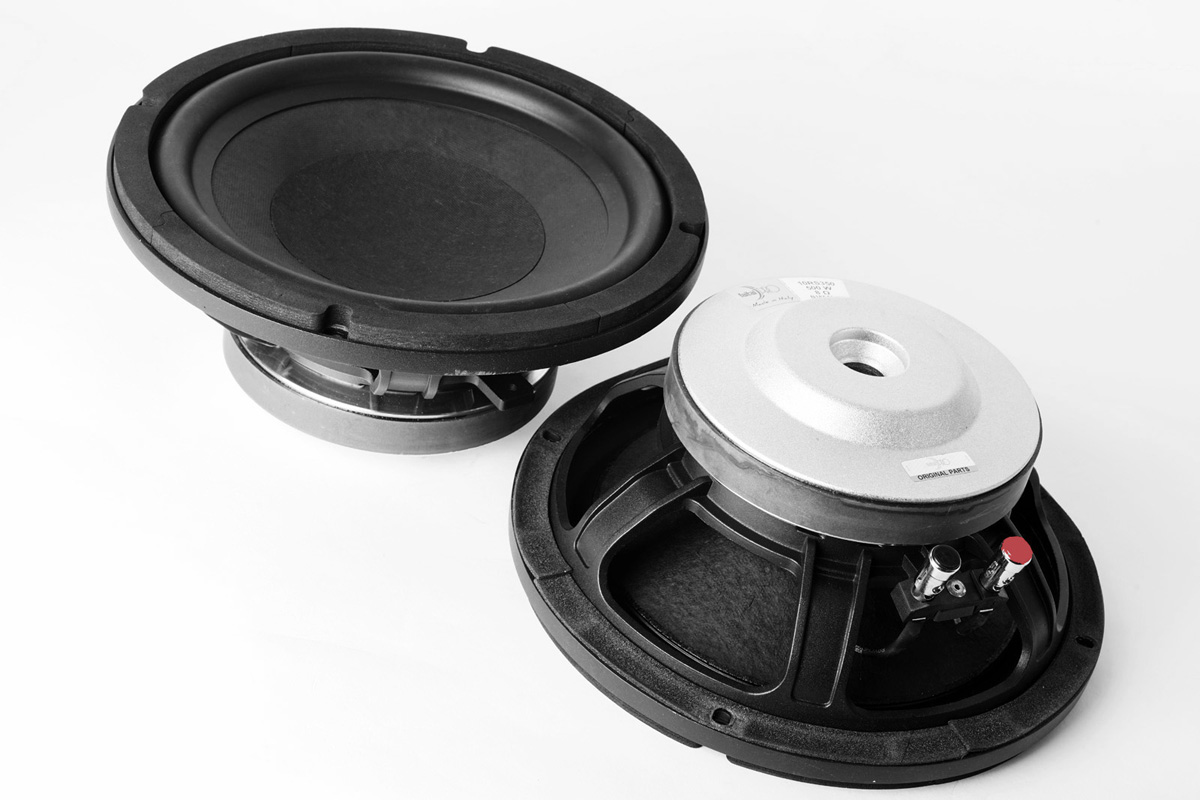
Download specs here: D2404/552000 18WE/8542T00 10RS350
The Faital bass driver has a rigid spider and needs some massage. Press the cone to the bottom and pull the cone as far out as possible until you hear the spider making a slight crackling noise. And DON'T stick your fingers through the cone!! Gentle but firm!
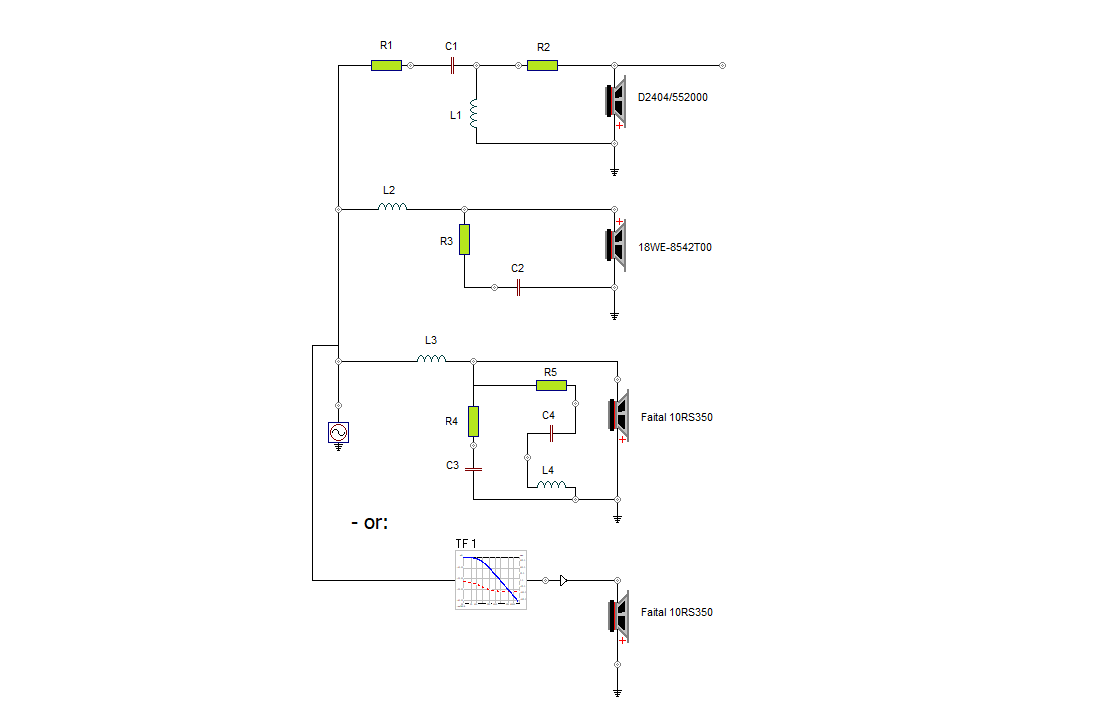
The crossover follows a textbook LR2 topology and initially I ran the
18WE from a single coil - and nothing else, just as I did with the
ATELL. Here I wanted to smooth the 18WE roll-off a little more, hence
C2/R3. This removes a slight peak around 4 kHz.
The bass crossover is very close to the ATELL crossover, only here 1st
order and the
impedance flattening circuit was added, something I omitted in the ATELL
design. Obviously the Hypex version is void all of this and the low-pass
section just mimics the passive low-pass function and cuts 1st order
around 150 Hz. In addition to this a 4 dB boost at 40 Hz and an
LR2 high-pass filter at 15 Hz for vinyl fans. The bass is deep and
powerful and can obviously be adjusted to almost any room condition.
From a lot of builders' respons, I can see many have problems with bass
boost below 100 Hz and also most likely have a dip around 150 Hz due to
speaker placement. This often comes from corner placement with equal
distance to side- and front wall. I many cases builders cannot place the
speakers symmetrically and one speaker may have a lot of room-gain - the
other a lot less. Most people cannot do much about it as speakers must
be where they are and there is no way we can adjust this with passive
means. Only the Hypex can do that - and easily. Go to Hypex info
here.
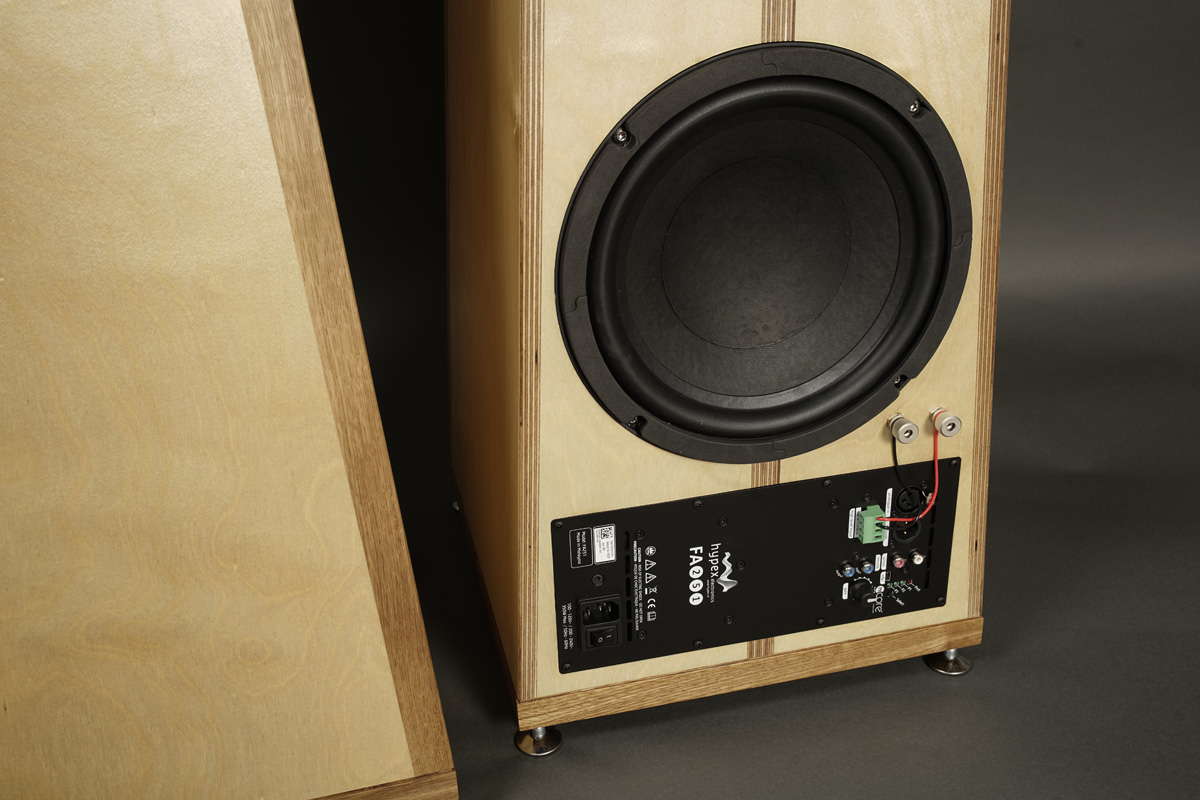
For the cabinets I used 20.5 mm Baltic birch and for the front panel 25
mm. 20 mm is OK. The mid-tweeter front was made from 25 mm
black MDF (HDF).
For the mid-tweeter brace I use 15 mm BB, use 15-20 mm.
I had 3 mm space between the two panels separating the bass and mid
cabinet.
The cabinet is in many ways similar to the ATELL-3, so go there to get more ideas of cabinet construction.

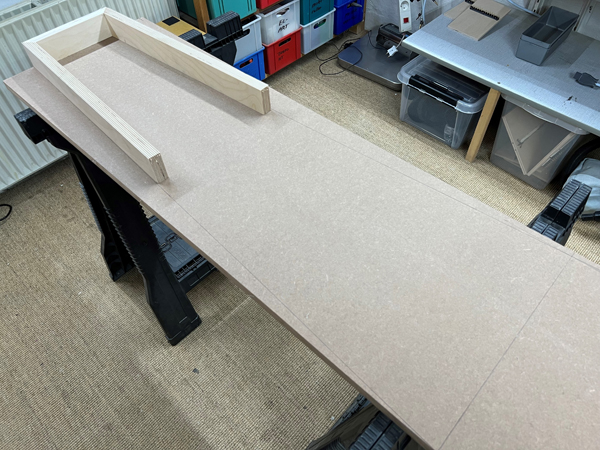
Use a clean sheet of MDF and draw up the shape of the cabinet to align
the panels properly as seen below.
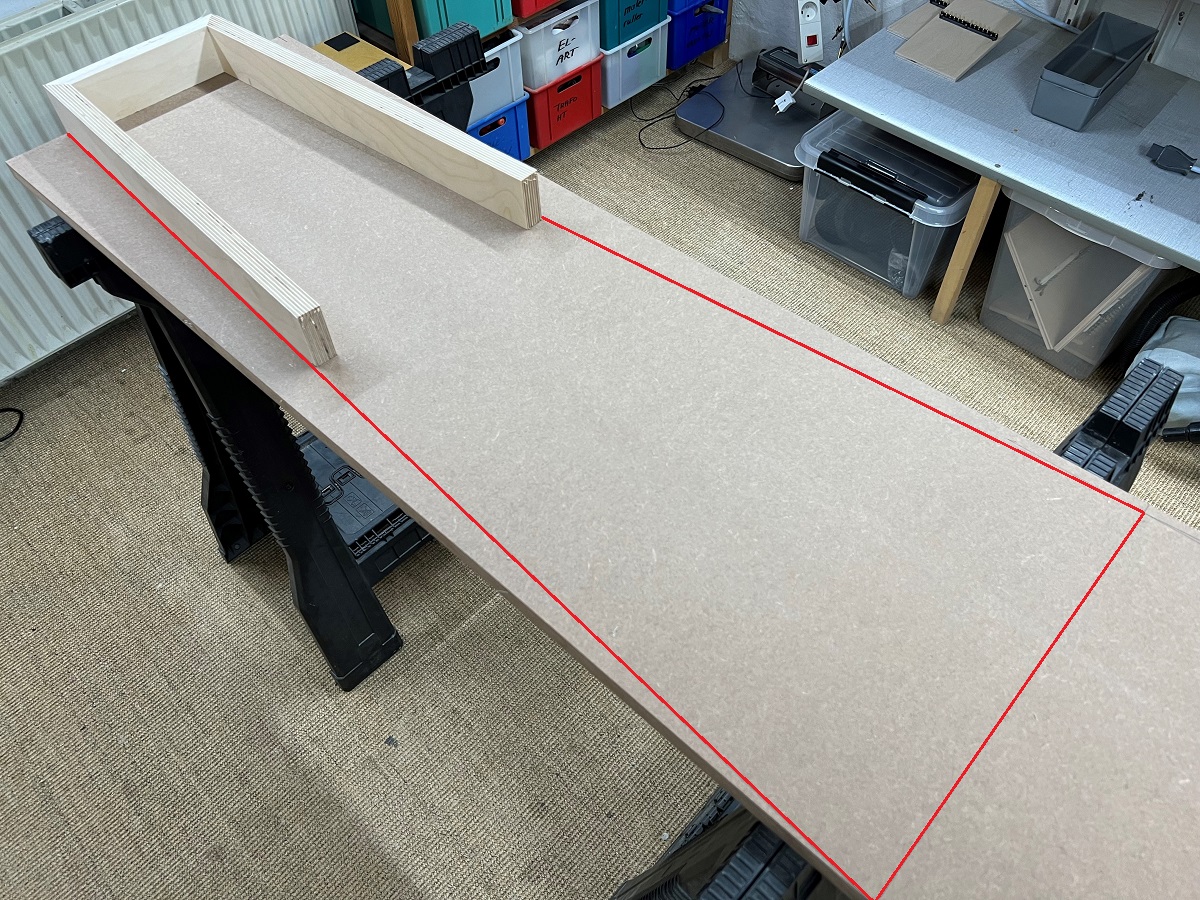
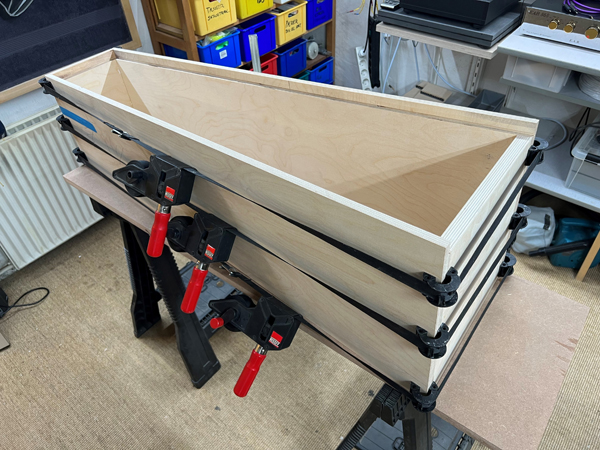
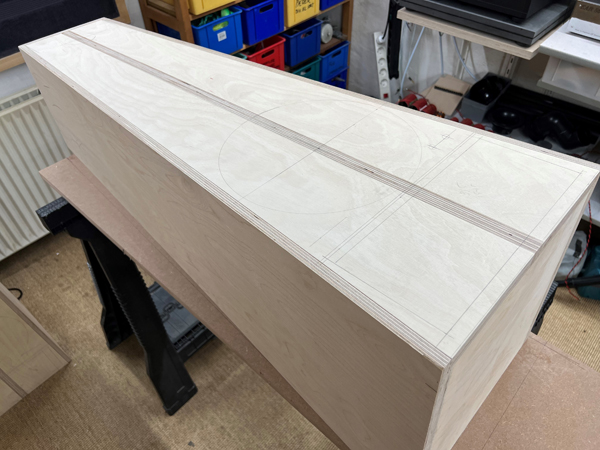
Making the rear panel fit the shape and
rebate is the most troublesome - in Baltic birch.
Using MDF and filler - piece of cake.
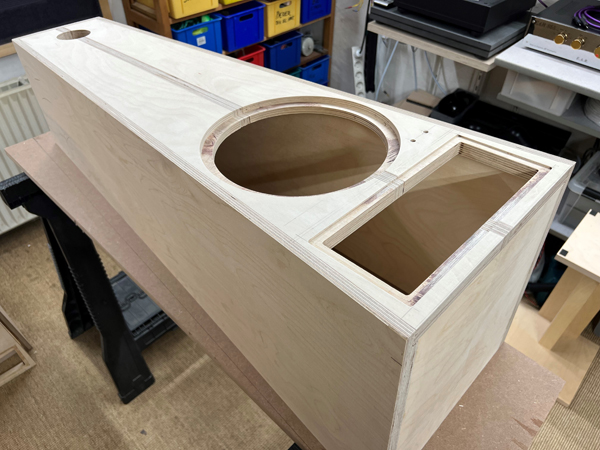
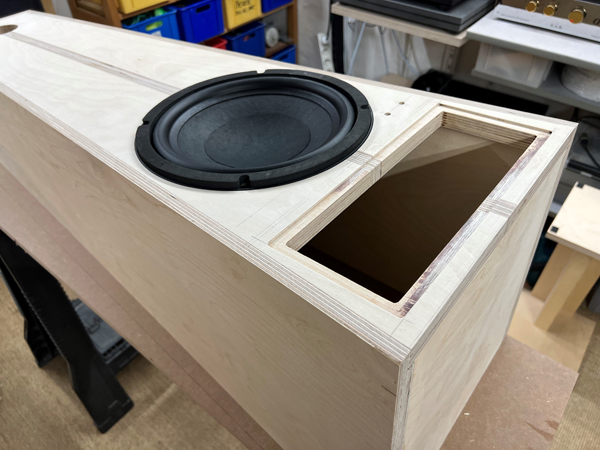
Route for the midrange port, bass driver and Hypex module.
The Hypex compartment can be use for the crossover if fully passive is
wanted - for bi-amping! If so, place the bass crossover in the bass
compartment and the mid-tweeter crossover in the Hypex compartment.
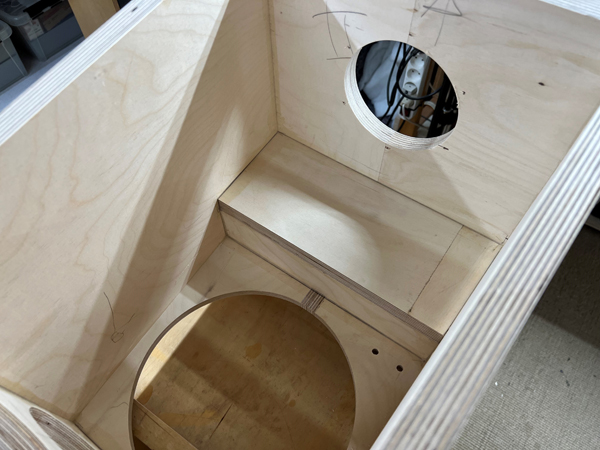
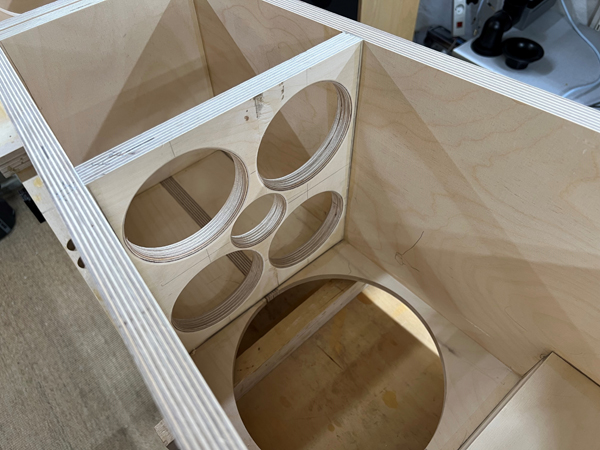
Left: Hypex compartment in place. Right: Bass
cabinet bracing.
Make holes as seen on photo.
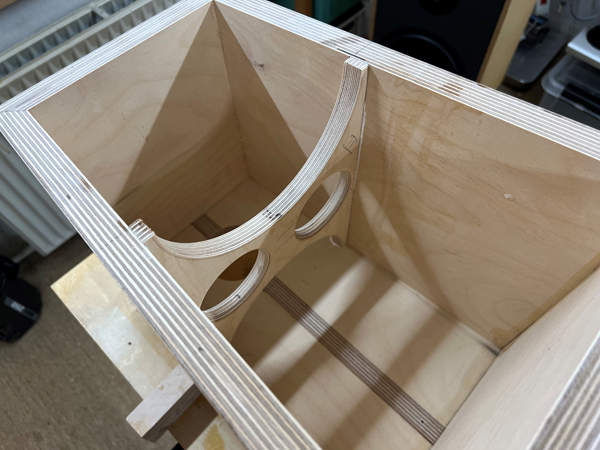
Mid-tweeter cabinet with brace. Make cut-outs
and holes as seen on photo.
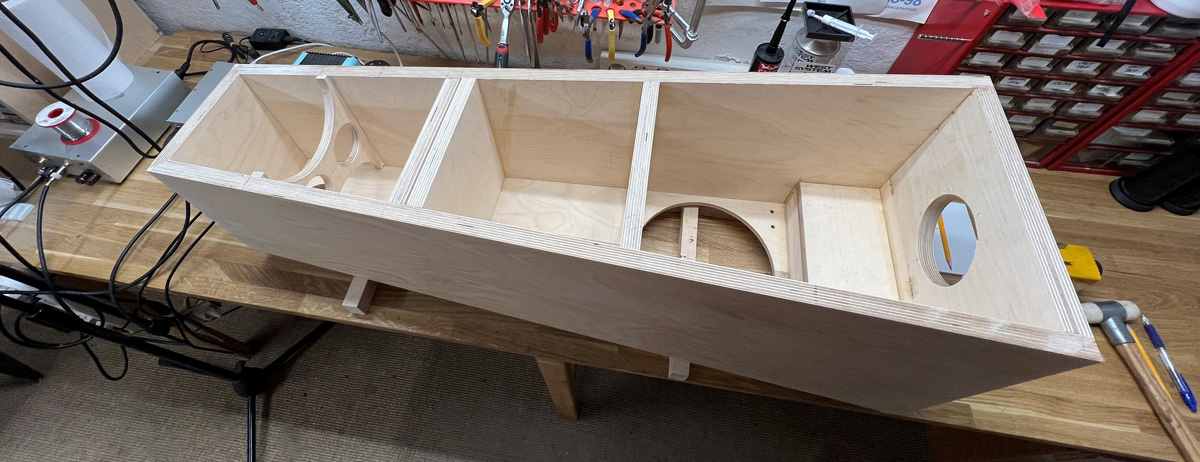
Cabinets with all braces in place. Now to the
bass cabinet front panel.
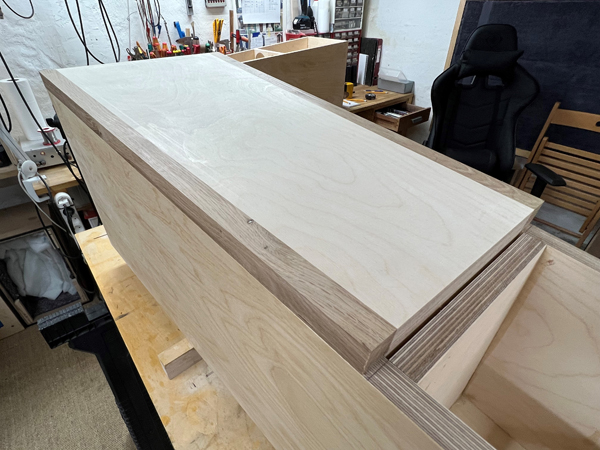
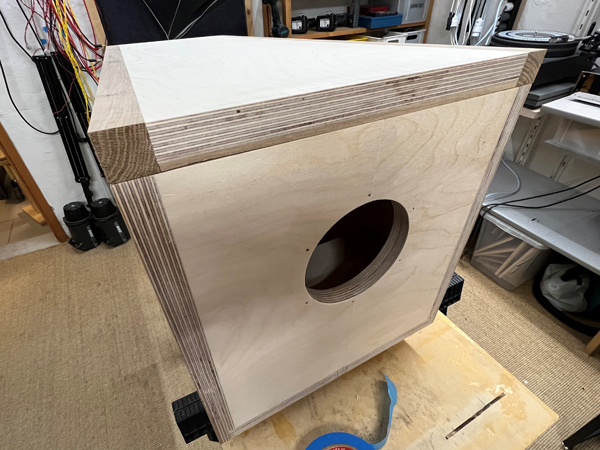
Making the lower front panel.
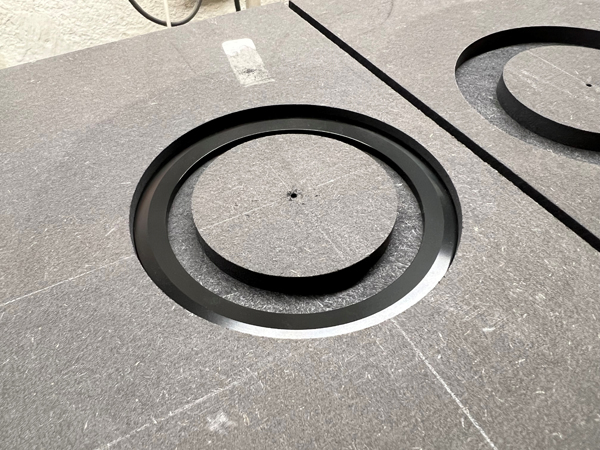
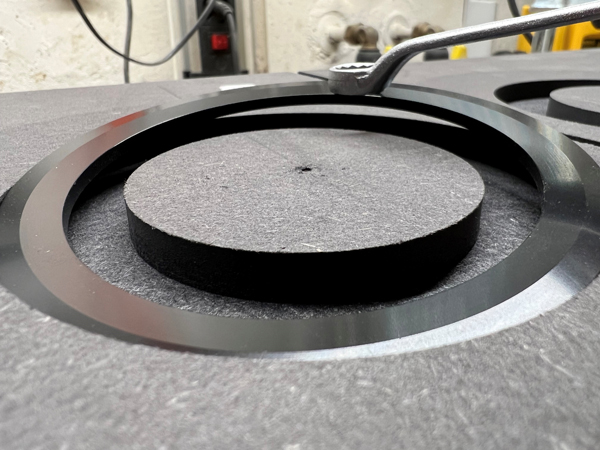
Make sure you have some gab between the decor
ring and and the rebate, otherwise you won't be able to remove it.
I took a router diameter some +0.5 mm to make sure I can lift the ring
with a wrench or similar (the ring has magnets).
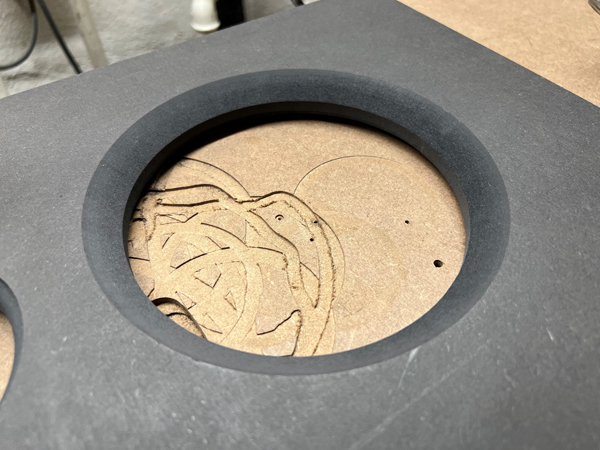
Chamfer
driver holes properly!
MDF/HDF and screws are not best buds. After drilling the screw holes, I
filled the holes with thin epoxy glue. The fibre material will suck up
the epoxy and provide a firm grip for the screws.
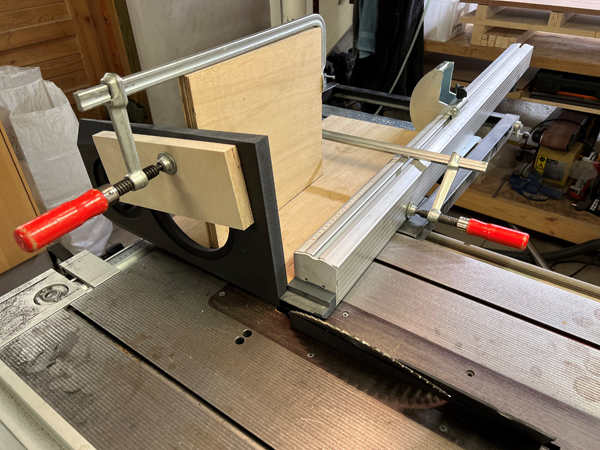
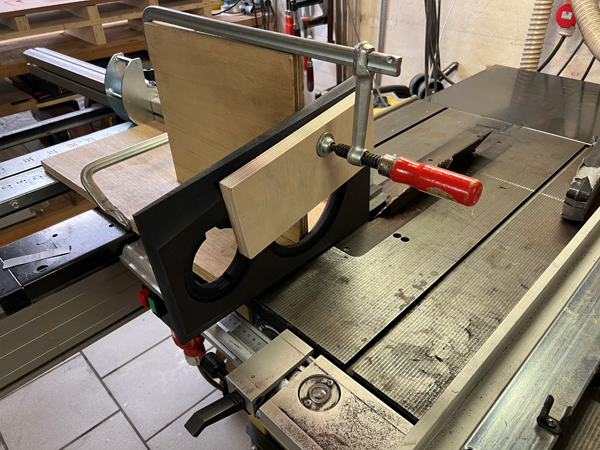
Faceting the front panels. Set table saw to
30 deg.
Set your gliding table guide at an angle of 3 deg.
The exact angles are 29.7 deg. vertical and 3.05 deg. horizontal.
Do test cuts to make sure it works correctly - and adjust to your
conditions.
At the top 35 mm wide and 20 mm deep.
And remember, all this can be done by hand:
Chisel/planer and sandpaper.

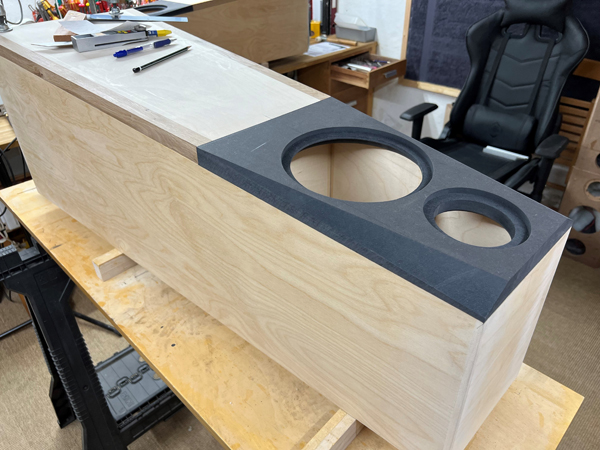
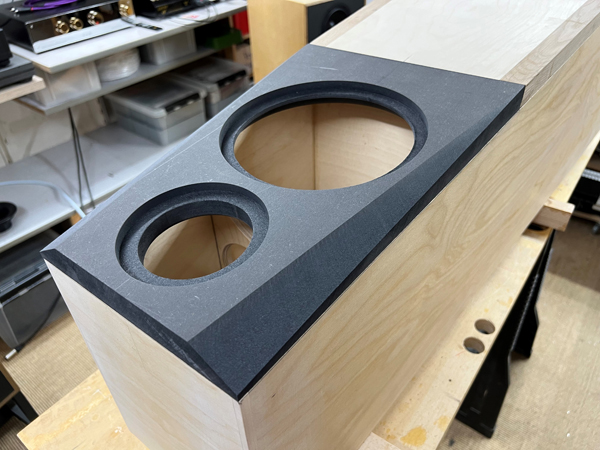
The finished front panels.
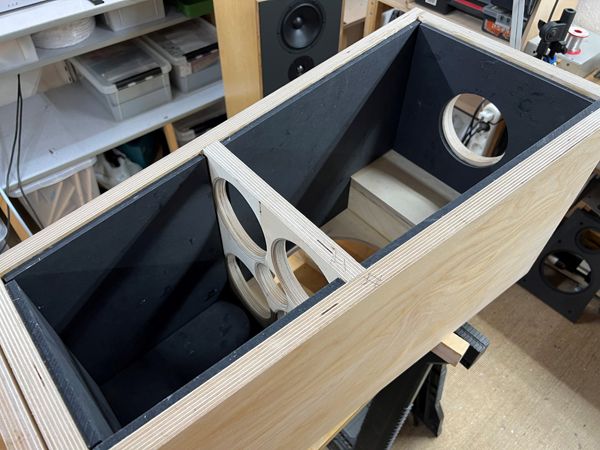
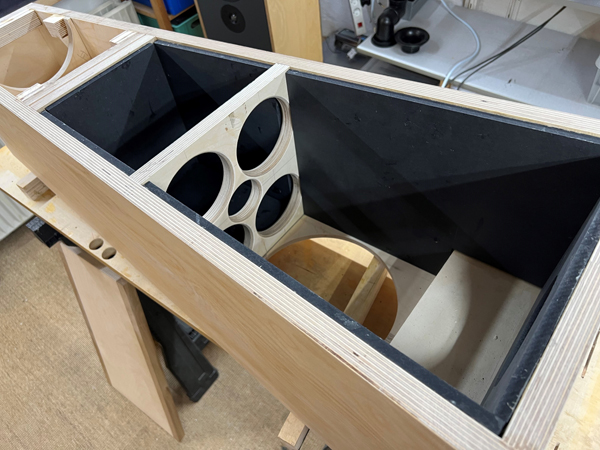
The bass cabinet was added 10 mm HDF to strengthen panels and reduce
volume.
Now we have around 39 litre net volume. The damping materials will add
in the area of 10% extra volume.
Use
vinyl glue for the panels, bitumen pads and
felt material.
The mid-tweeter cabinet was added 4 mm bitumen pads on all sides except
rear panel, where the passive crossover will be placed. Before you glue
the bass front panel, make sure to drill a whole for wires from
terminals to mid-tweeter section.
Seal wire hole with Superfix or similar.
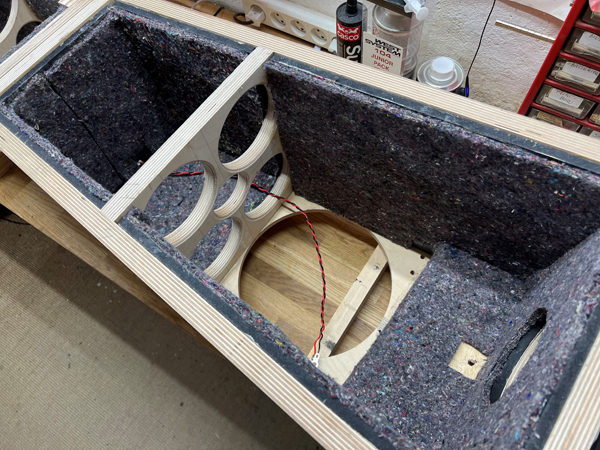
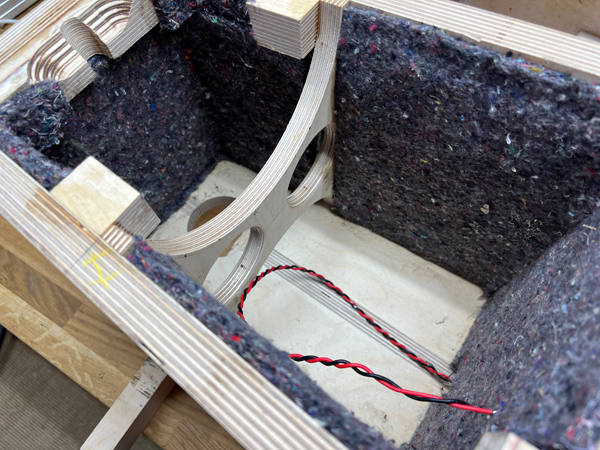
Cover all internal panels with felt except for mid-tweeter rear panel
(right).
My mid-tweeter front panel was made detachable, as I have plans for more
versions. Don't ask, please!
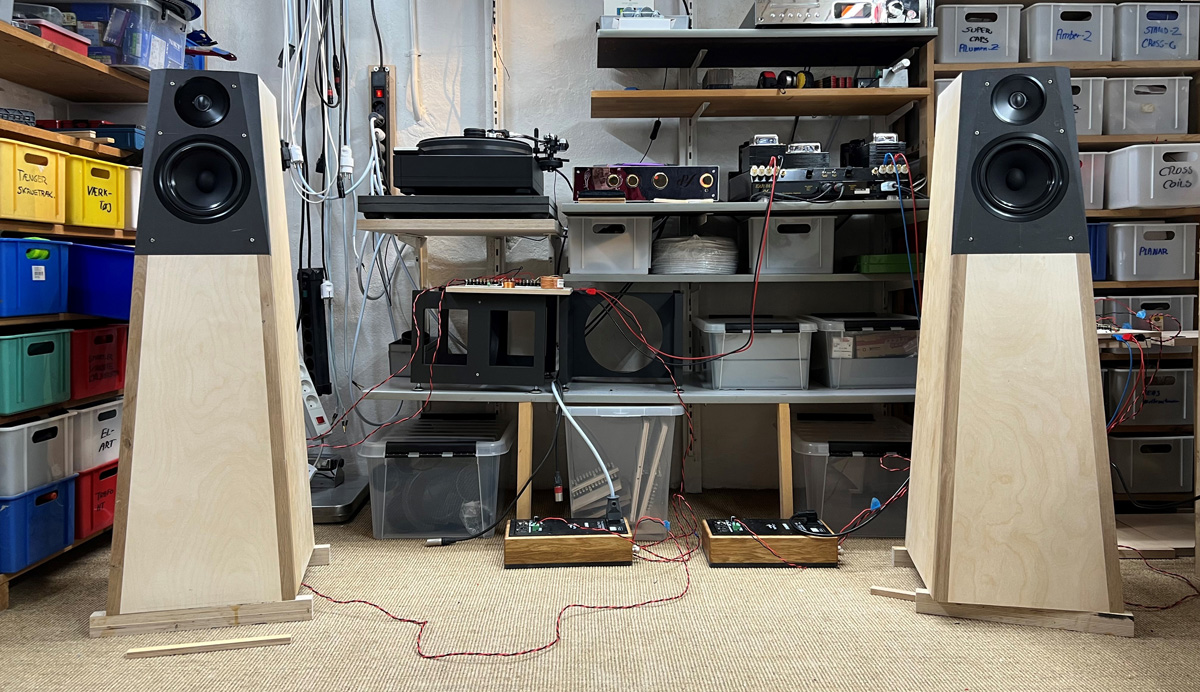
Before finishing the cabinets I couldn't help
setting up the speakers to do the final measurements, simulations and
prototype crossovers. The dynamic headroom of these 18WE drivers is
phenomenal. Even the Tin Pan Alley came through at thunderous levels -
with deep potent bass.
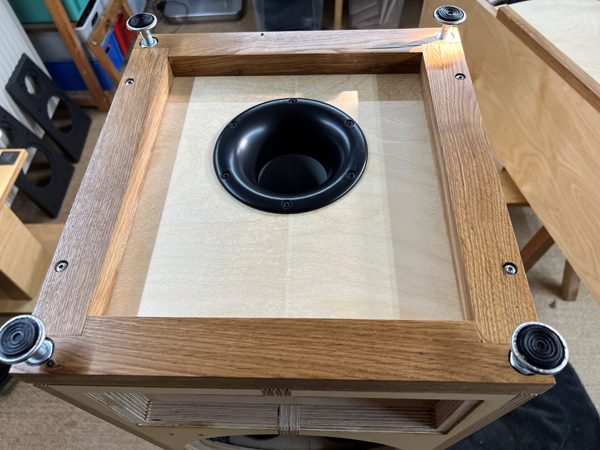
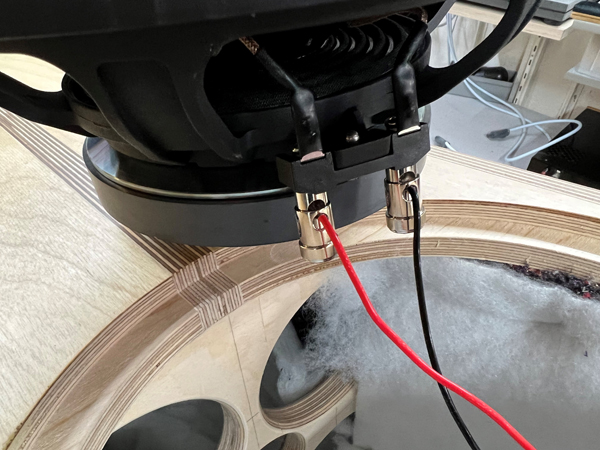
Left: Mounting the bottom frame, here in
solid oak. Right: Wiring the bass driver.
Place 1 pcs 50 x 50 cm acoustilux at top of the bass cabinet.
Place 2 pcs 40 x 50 cm acoustilux on sides of bottom of bass cabinet
leaving two layers at the back.
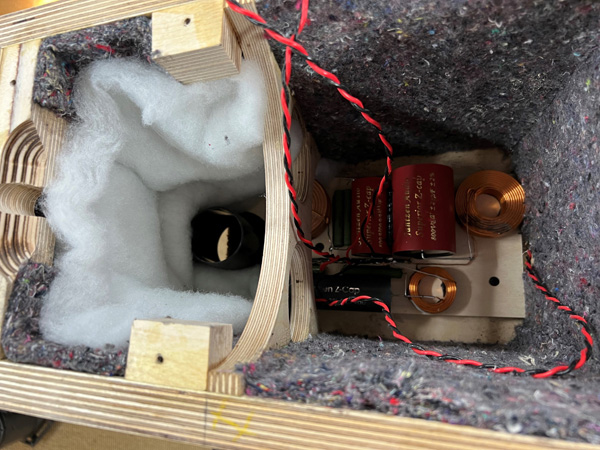
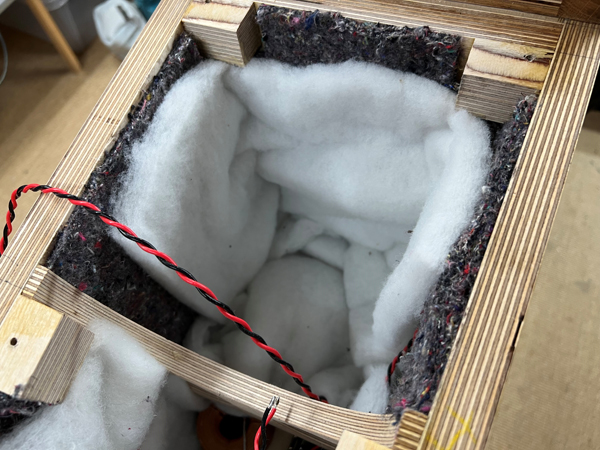
Add 1 pcs 20 x 50 cm at top of MT cabinet.
Add 1 pcs 20 x 20 cm on top of crossover.
Add 1 pcs 20 x 50 cm at bottom and sides of MT cabinet.
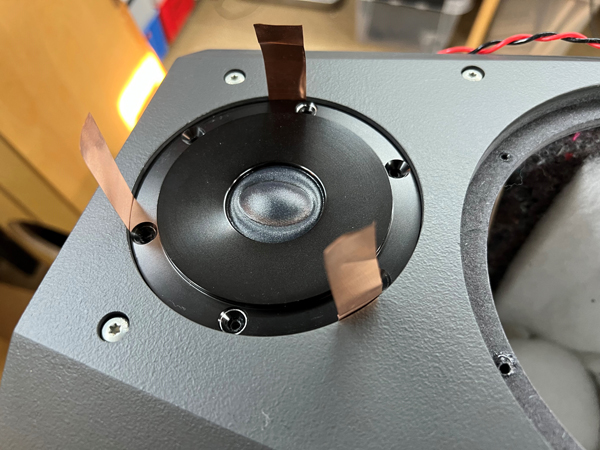
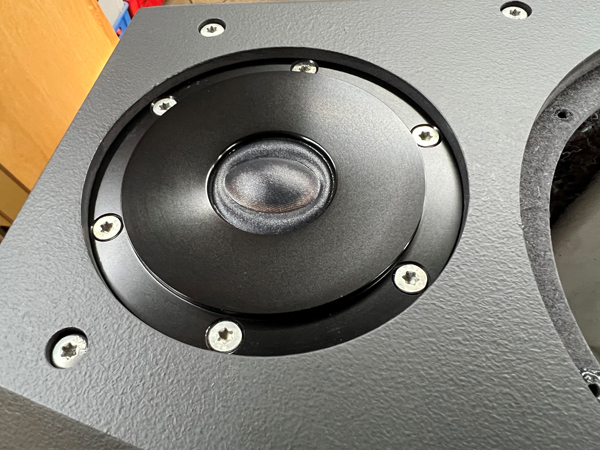
Mounting the Ellipticor driver is a bit
tricky.
Make sure you have some space around the driver for the decor ring to
move freely! Use some foil to make sure you keep some space when adding
the screws. If not, you will never be able to remove the decor ring.
I used some countersunk screws found at the local Bauhaus, 4 x 20 mm.
I'd say that 6 screws for a small tweeter like this is overkill, but
that's what the ScanSpeak people decided.
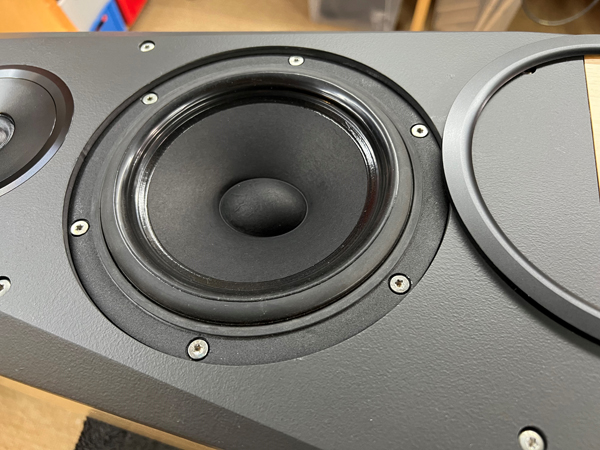
Same goes for the 18WE decor ring.
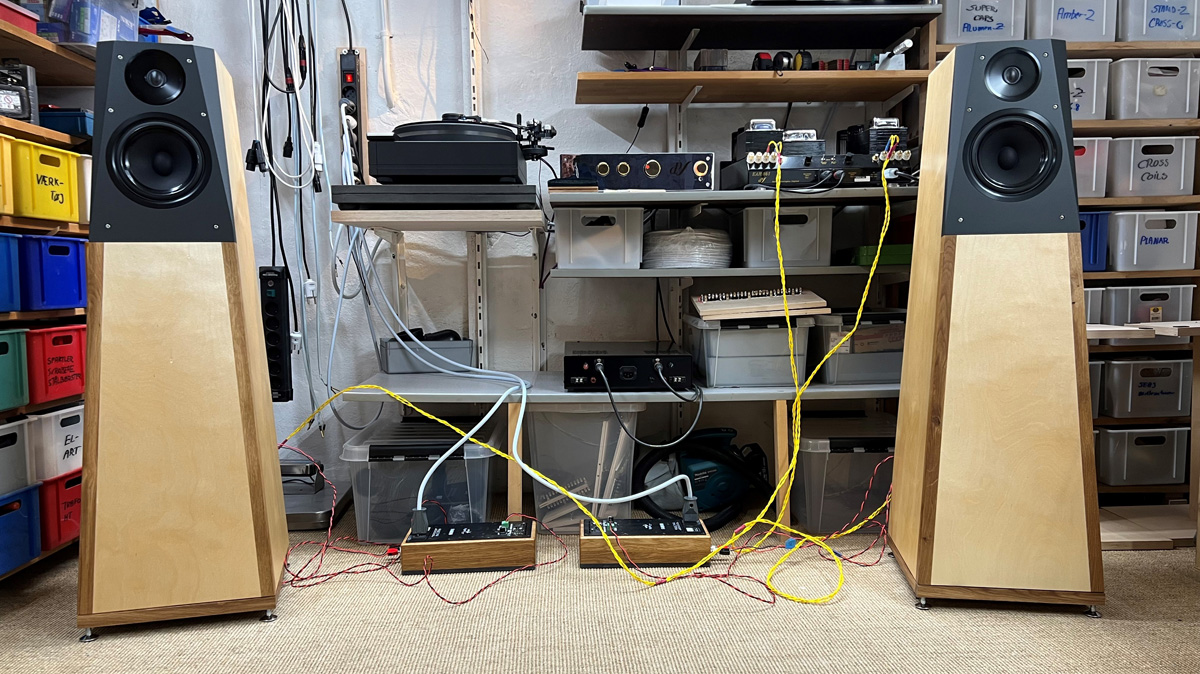
The almost finished speakers in my workshop.
Hypex modules on their way and my stock FA501s running the bass.
This is the time you lean back and see of the final results resembles
what you had in mind when starting contemplating the whole project.
Pretty close to what I had in mind.
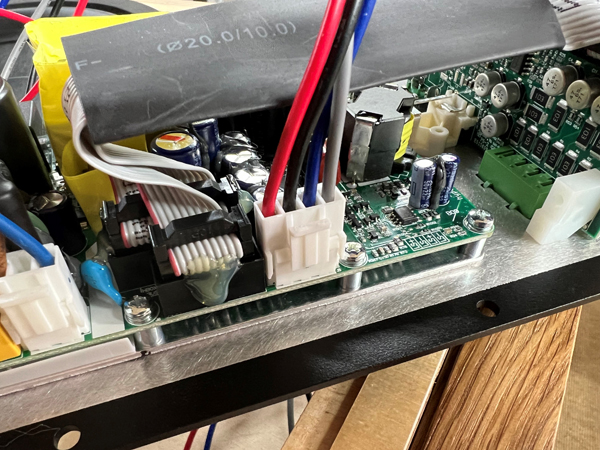
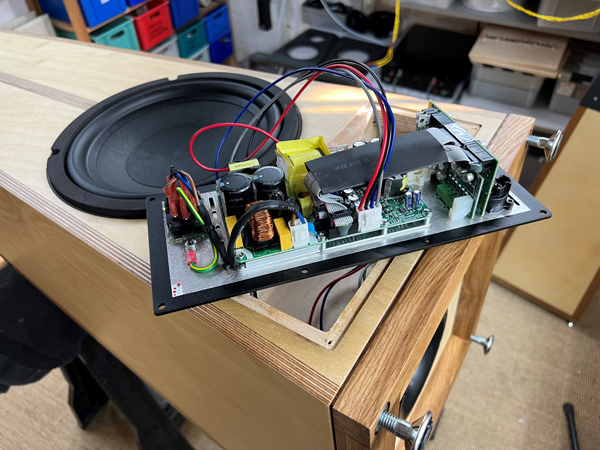
Mounting the Hypex module.
Combine read and blue = PLUS
Combine grey and black = MINUS.

As can be seen I reversed the polarity of the
bass driver at the high-level input.
Go to Hypex programming
here.
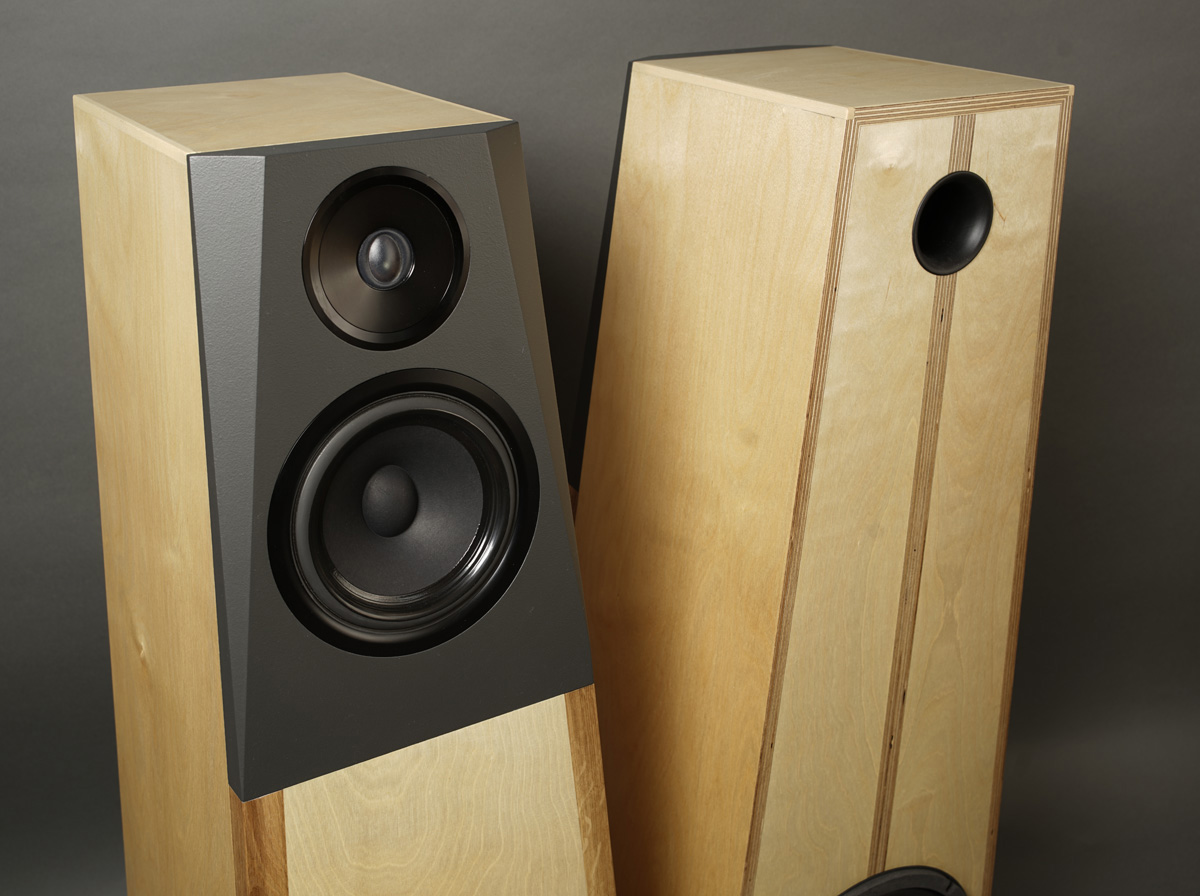
A few comments on
MEASUREMENTS before you start interpreting the readings below.
First of all, if we think measurements will
tell us how a speaker sounds, we're wrong. The perception of sound is
way too subjective to be reflected in any measurements we can perform. A
loudspeaker system is meant to give us a satisfying idea of an acoustic
event and for some people a pair of 5 USD ear-plugs are enough, others
spend 200 kUSD on a truly full-range pair of speakers - and the latter
may not be happier than the former.
Measurements may give us an idea of tonal balance of a system, i.e. too
much or too little energy in certain areas, although dispersion
characteristics play a vital role here. A two-way 7+1 and a three-way
7+4+1 may display similar horizontal dispersion, yet sound very
different. Measurements may tell us about bass extension if far-field
measurements are merged with near-field measurements. In addition to
this, ports may contribute to bass extension. Most of we diy'ers do not
have access to an anechoic room for full-range measurements from
20-20000 Hz.
What cannot be seen is what kind of bass performance we get in a given
room. Bass performance is highly dependent on in-room placement of your
speaker and the same speaker can be boomy in one place and lean in
another. Actual SPL level at 1 meter distance and 2.8V input is useful
for en estimate of system sensitivity and combined with the impedance
profile may give an idea of how powerful an amplifier is needed to drive
the speaker to adequate levels.
What measurements do not tell is the very sound of the speaker unless
displaying serious linear distortion. The level of transparency, the
ability to resolve micro-details, the "speed" of the bass, etc., cannot
be derived from these data. Distortion measurements rarely tell much
unless seriously bad, and most modern drivers display low distortion
within their specified operating range.
Many people put way too much into these graphs and my comments here are
only meant as warning against over-interpretation. There are more to
good sound than what can be extracted from a few graphs. Every graph
needs interpretation in terms of what it means sonically and how it
impacts our choice of mating drivers, cabinet and crossover design.
What measurements certainly do not tell is the sonic signature of the
speaker, because speaker cones made from polypropylene, aluminum,
Kevlar, paper, glass fiber, carbon fiber, magnesium, ceramics or even
diamonds all have their way of adding spices to the stew. Nor do
measurements tell what impact the quality of the crossover components
add to the sound, from state of the art components to the cheapest of
coils and caps, they all measure the same if values are correct, yet
sound very different.
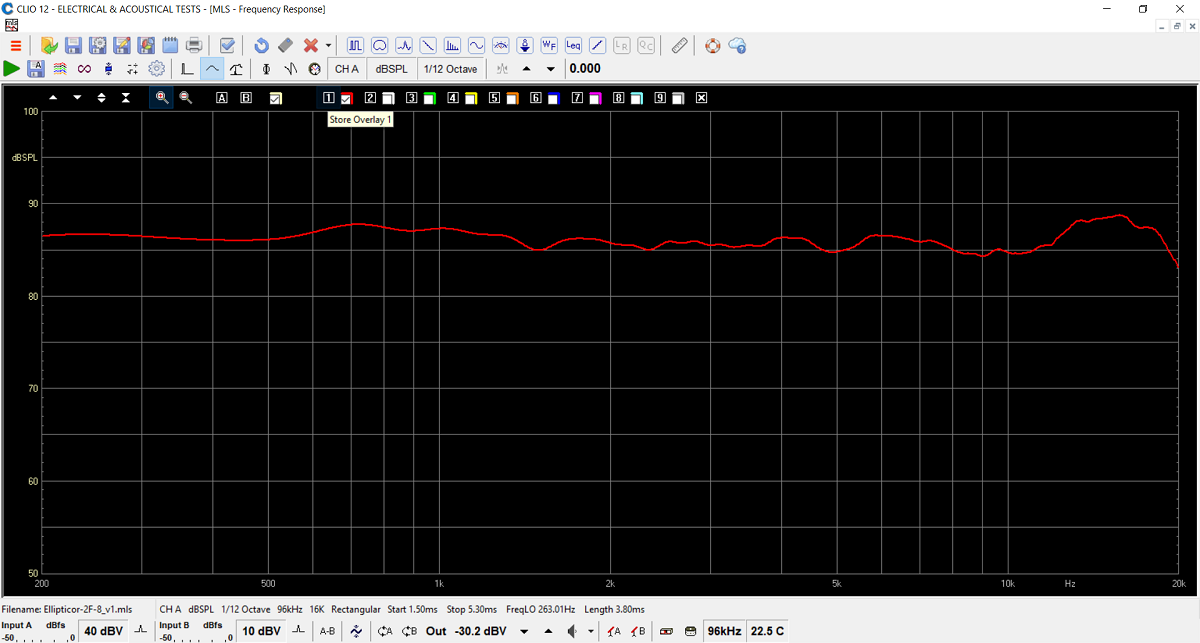
Frequency response of 18WE and D2404 measured
at 0.5 meter distance at a point between drivers.
The 2404 has a slight increase in response above 10 kHz, but I decided
not to do anything about it as it will even out when we look at
horizontal dispersion. See below.
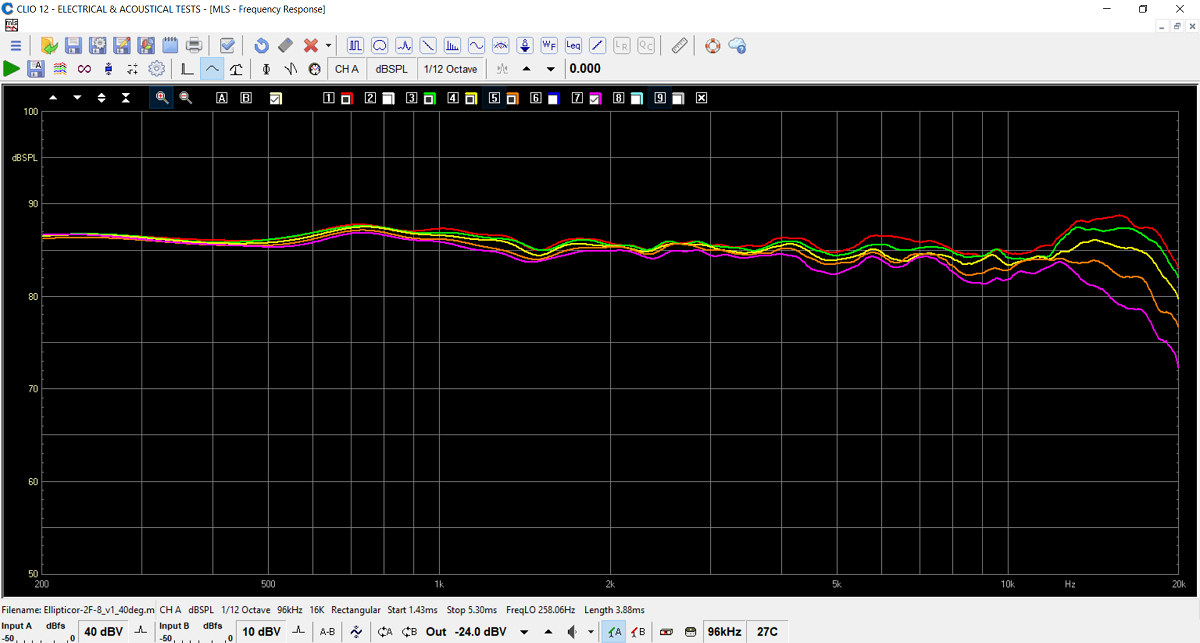
Horizontal dispersion of 18WE/D2404 at 0,
10, 20, 30 and 40 deg. off-axis.
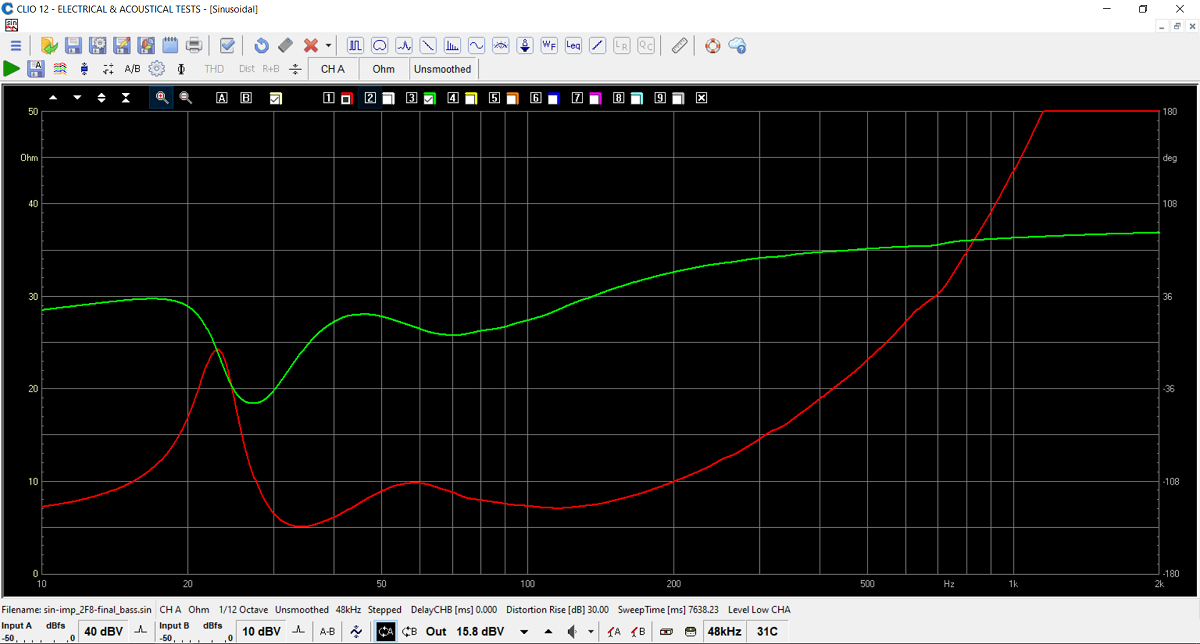
Impedance profile of bass alone driven from
passive crossover.
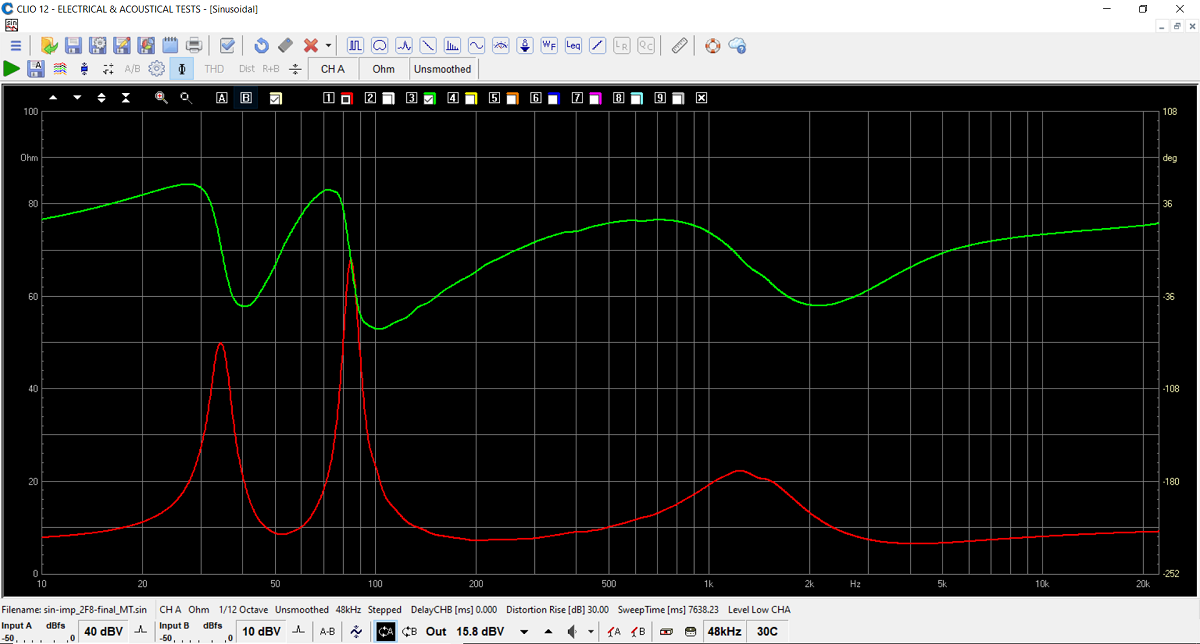
Impedance of MT section driven from
crossover.
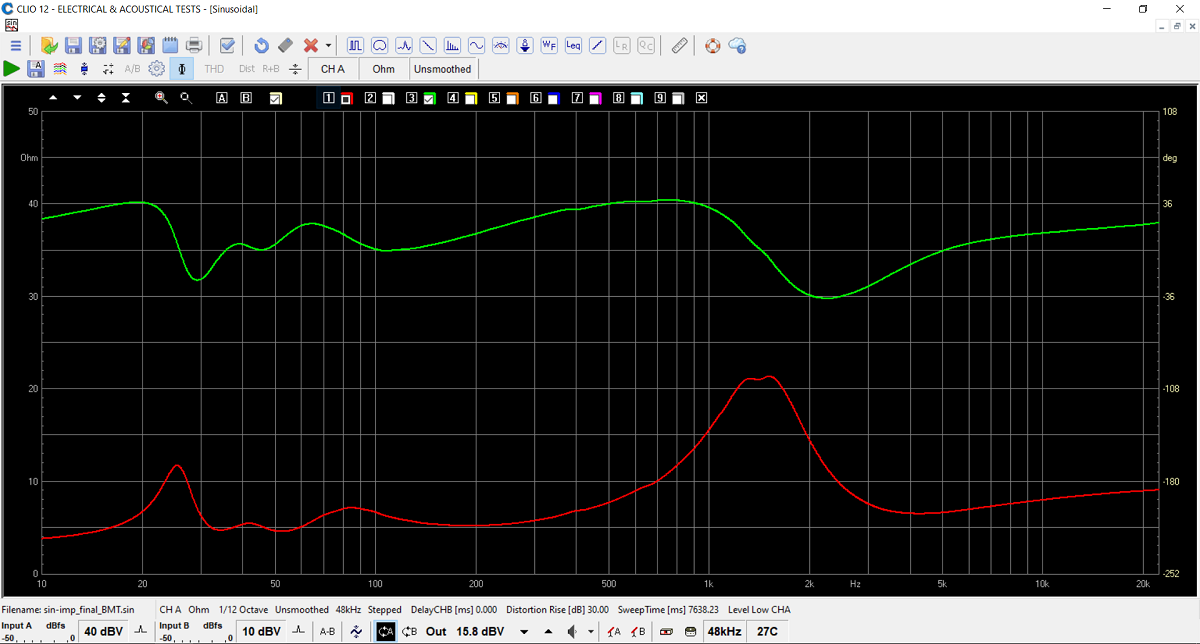
Combined impedance of bass module and MT
section. Overall an easy load and my bridged EAR-861 has no trouble
running the fully passive version.
Minimum impedance around 4.5 Ohms in critical area (20-100 Hz).
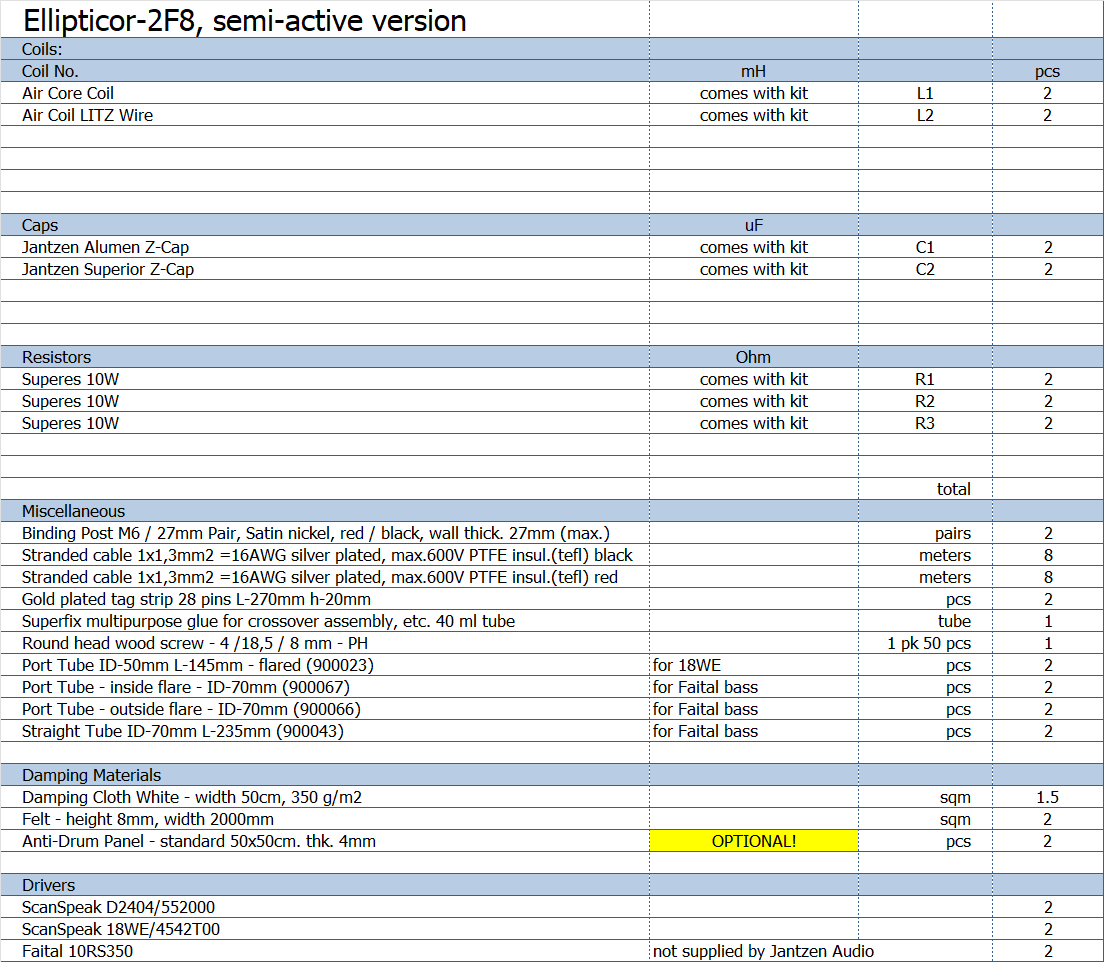
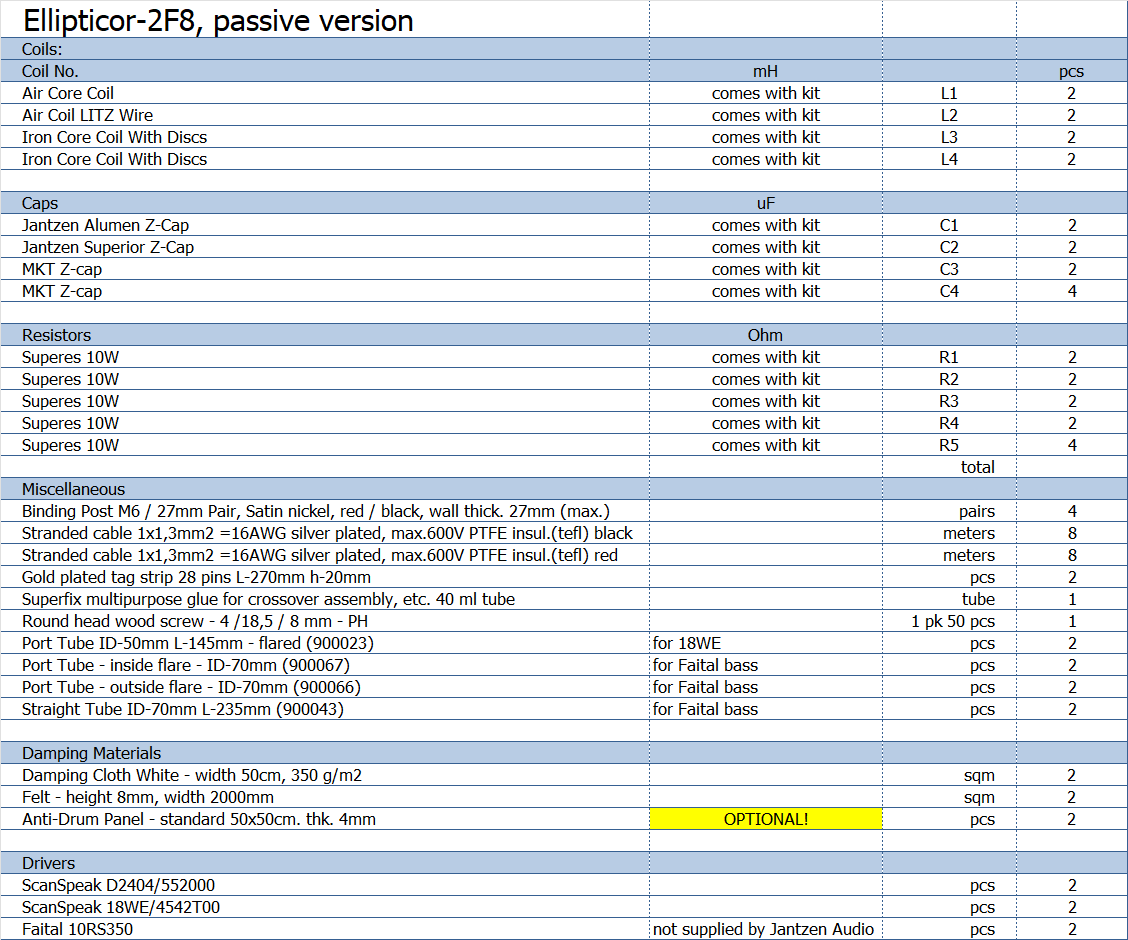
All kit and component prices may be subject to change and are always to be confirmed by Jantzen Audio Denmark.
Kits can always be bought with/without drivers, or some of the drivers.
Download Complete Kit Sale Presentations:

All technical questions to troels.gravesen@hotmail.com
All questions regarding purchase of kits, please mail Jantzen Audio at contact@jantzen-audio.com
CROSSOVER-LAYOUT
BACK TO INDEX
Check this out before start making crossovers:
http://www.troelsgravesen.dk/tips.htm#CONSTRUCTION_OF_CROSSOVERS
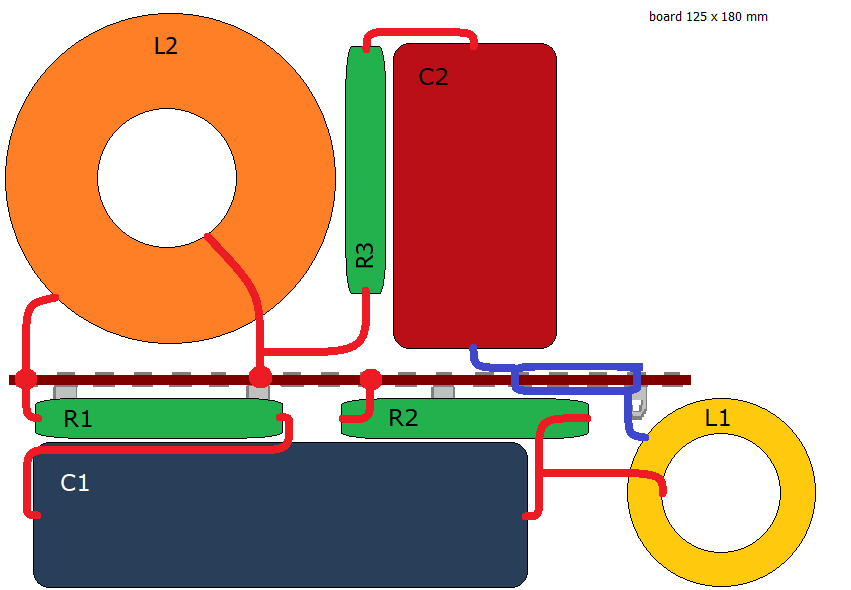
MT section layout.
Cut the two supplied solder tag strips in two.
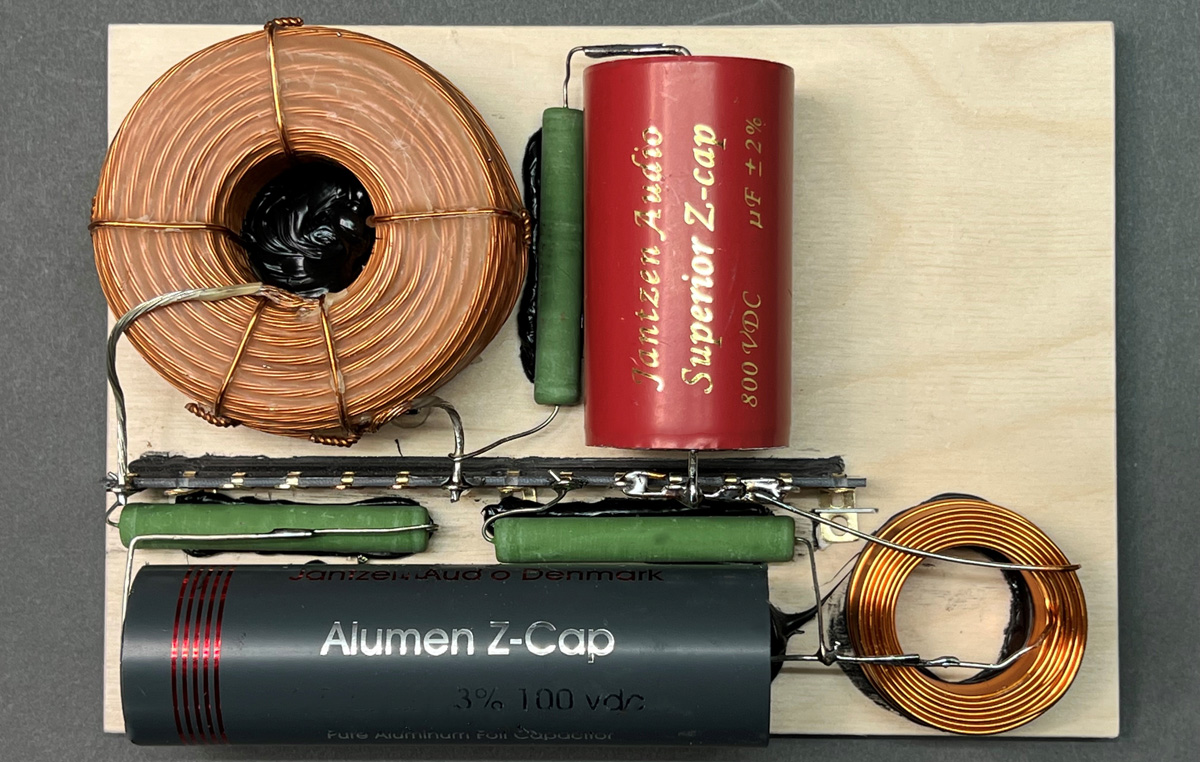
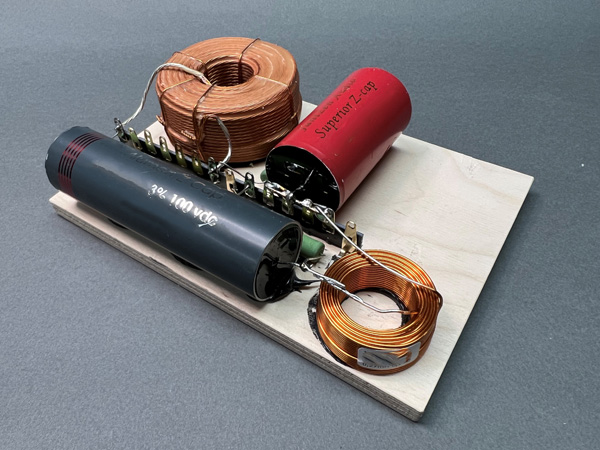
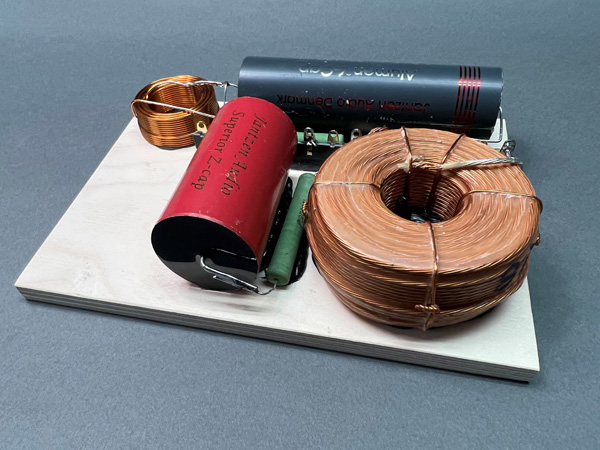
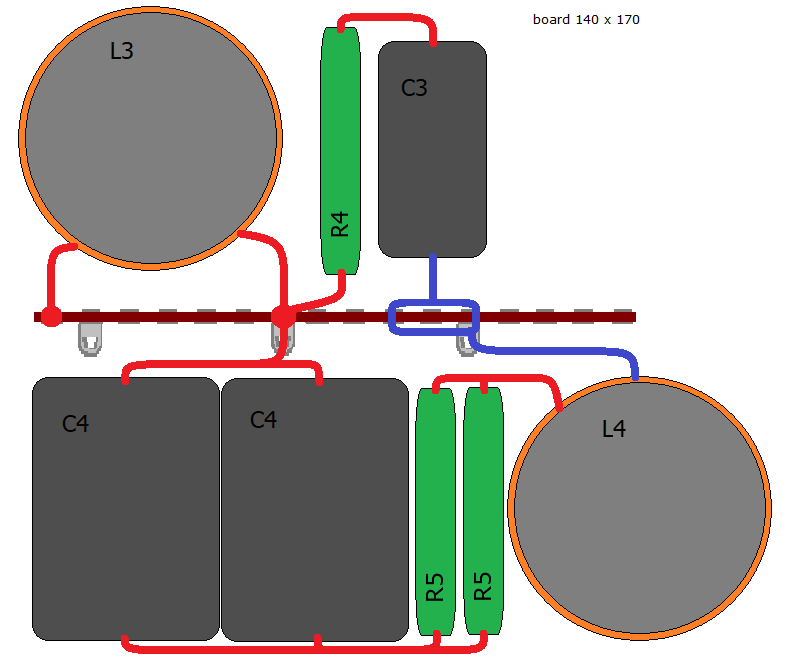
Bass layout for fully passive version.
Speaker wiring:
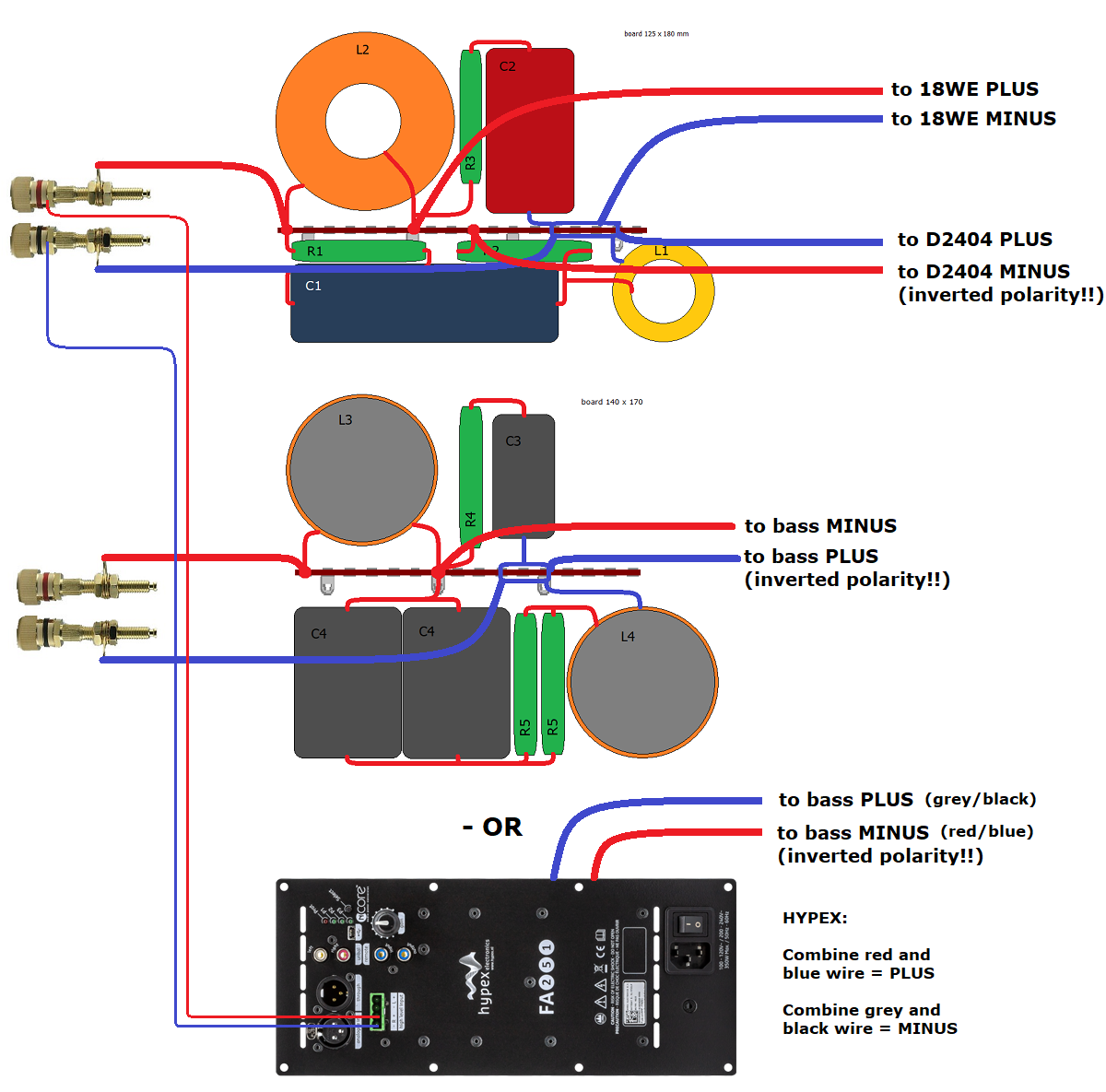
Short introduction to programming the Hypex module:
Further info on Hypex programming here.
Update firmware before installing the software.

Download
FA Update Tutorial V0300.pdf
Download Ellipticor-2F software here. zip file, unpack and place the Folder in the FilterData folder the HFD software has created under Documents.
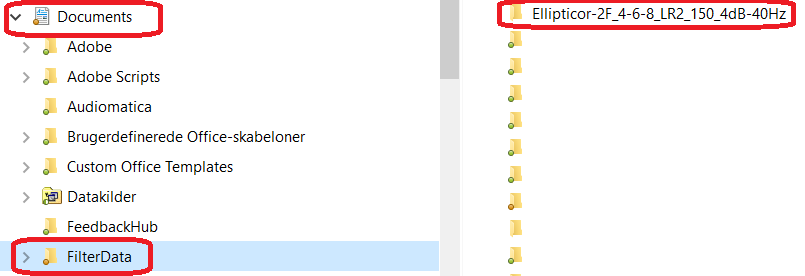
Turn on your FA251 and connect to PC via USB cable.
Update firmware. See above.
Set all presets, 1-2-3, to AnalogueSUB input.
Set volume to 0 dB.
Click Device setting:
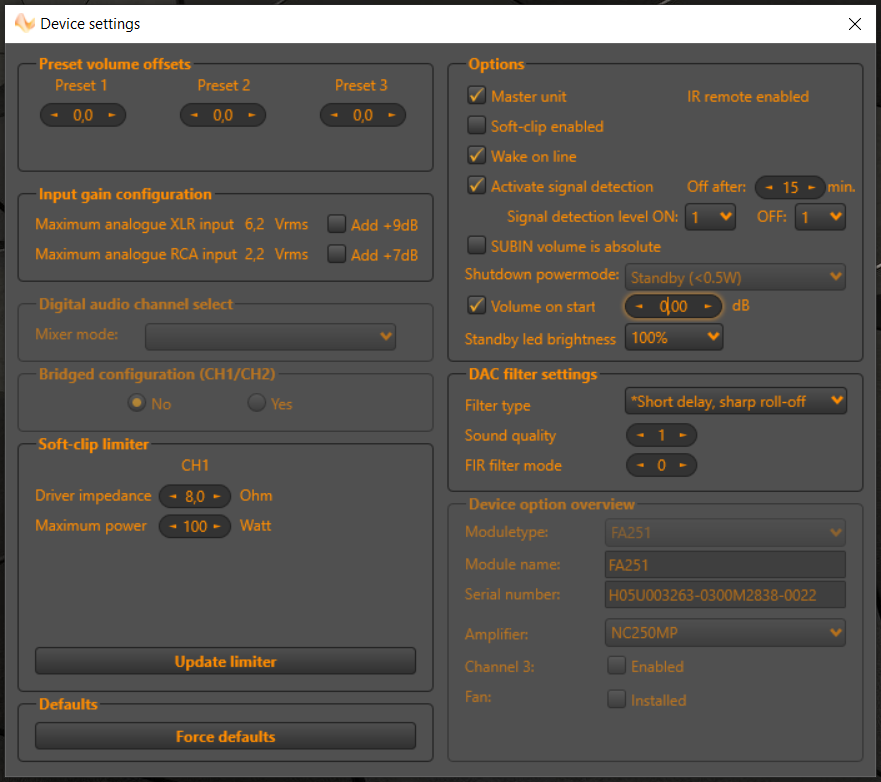
Set driver impedance to 8 Ohms.
Set volume start to 0 dB.
All other settings as seen above.
Click Update limiter.
Undo window and you're back to this:
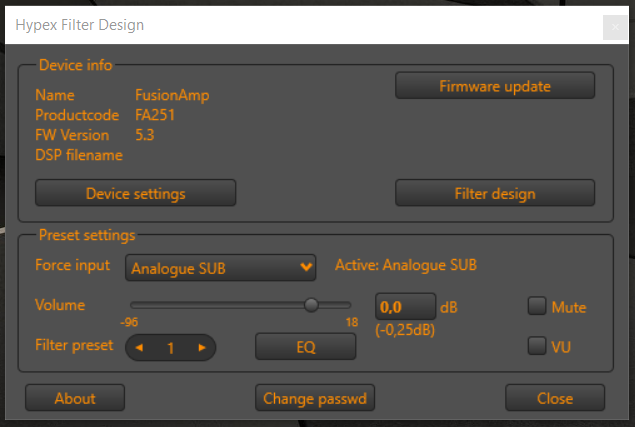
Click Filter design and you have this:
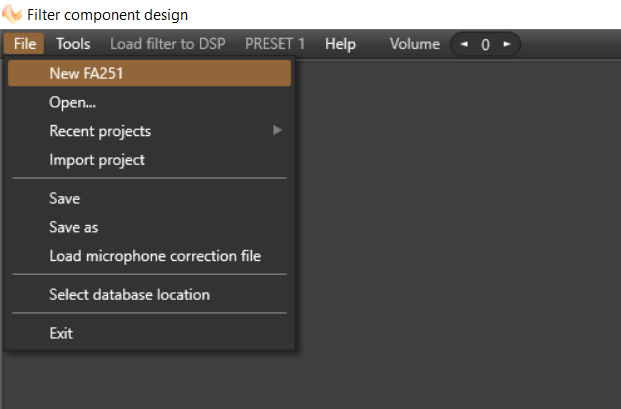
Click New FA251.
Click Open:
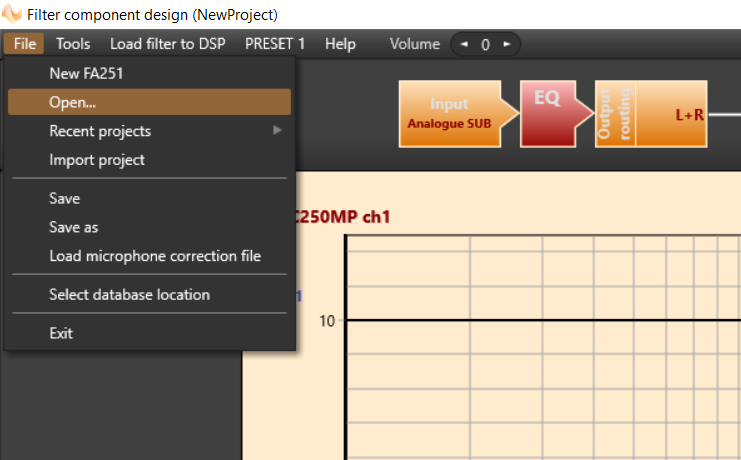
This will open the FilterData folder in your Documents folder.
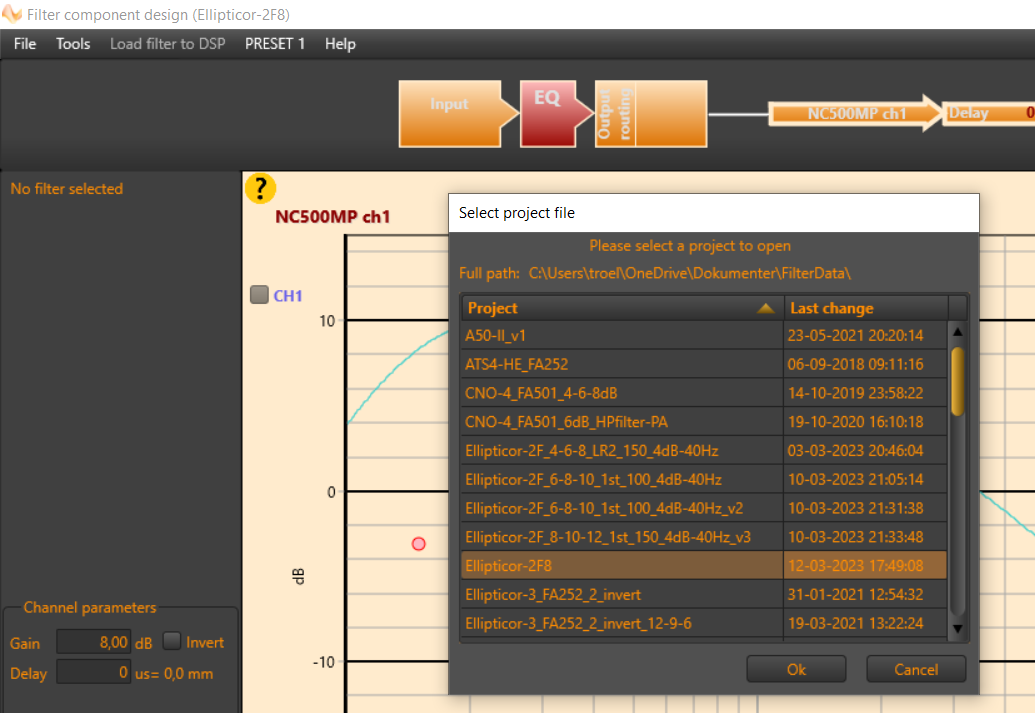
Click the file Ellipticor-2F8 and press Ok and you will have this:
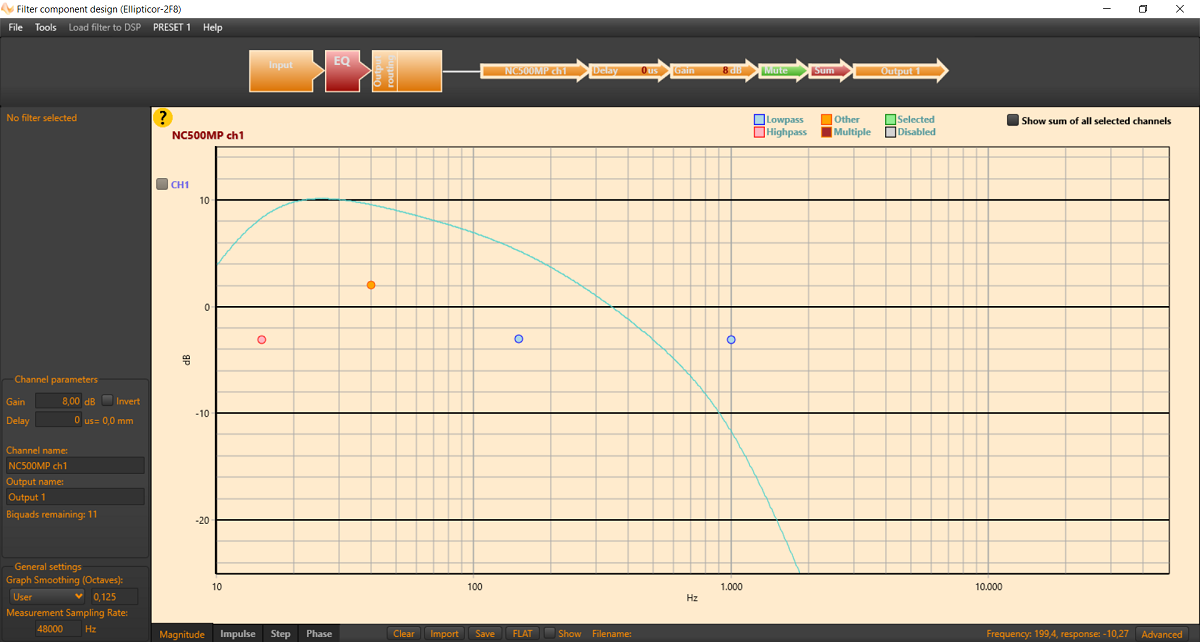
1st order @ 150 Hz and further low-pass LR2 at 1000 Hz to remove any peaks above this.
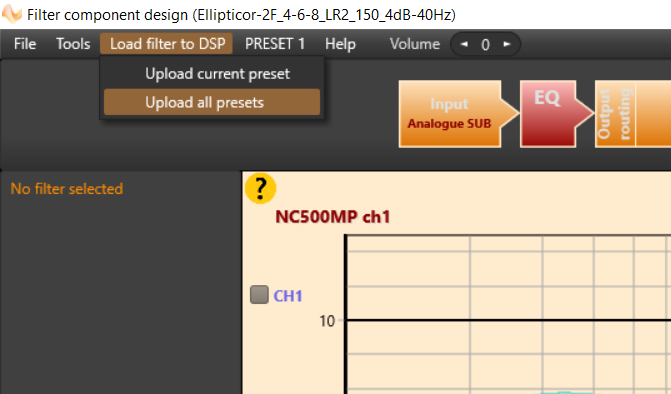
Upload all presets and you're done.
Set the volume control on the Hypex panel as 12 o'clock.
Preset 1-2-3 has 8, 10 and 12 dB gain and usually 10 dB will do, but try it out.
Use preset 1 or 3 if 2 is too much or too little.
